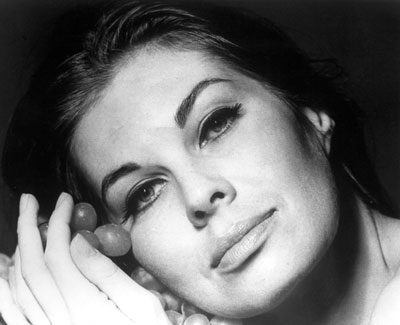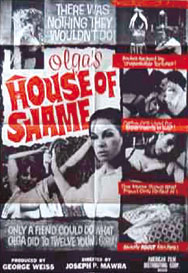A GIRL NAMED OLGA
By Arnold Salas
 |
| Audrey Campbell photo by Lee Kraft. |
BEFORE THE END of Hollywood’s production code and the rise of hard-core pornography, some of independent film’s most creative minds were hard at work in the exploitation, soft-core and nudie genres. A few elevated their craft into an art form. Russ Meyer, Joseph Sarno and Radley Metzger all flourished during the 1960s, offering that extra something the European imports didn’t – violence, plus an underlying American sense of morality.
A lesser-known name is Joseph P. Mawra, director of such cult fare as All Men Are Apes and Shanty Tramp. Mawra struck paydirt in 1964, just as American sex films were spicing things up with torture and bondage – new subgenres that included the "nudie-roughie" and the "nudie-kinkie." Mawra’s cult hit White Slaves of Chinatown introduced the sadistic Olga Saglo (Audrey Campbell), adept in white slavery and narcotics pushing. In the film, Olga works for an unnamed syndicate, procuring girls for well-off older men and even peddling dope to schoolkids. She also ruthlessly tortures her female victims in a basement dungeon, turning them into prostitutes and drug pushers after breaking their spirit.
 |
| Still from Olga's Girls courtesy of First Run Features. |
Still working in film and television, Campbell is a bit mystified by her character’s longevity. "To this day people recognize me as Olga on the street," she says. "I’m not quite sure what the appeal of the films is exactly, since so many different kinds of people seem to enjoy them. Perhaps it’s that I played her straight, with the ponytail, white blouse and boots. I didn’t make Olga a slut."
Director John Waters still remembers thrilling to Olga’s exploits in a Baltimore theater as a teenager. "I couldn’t get over the title," he exclaims. "I have to force myself everyday not to think about Olga’s House of Shame."
 Although Olga is an unlikely poster girl for feminism, there’s no doubt that her strength and unwavering domination over those around her appeals to both women and gay men, at the same time titillating straight men who thrill to her escapades. Whatever its attraction may be, Joseph P. Mawra’s Olga phenomenon doesn’t seem about to go away anytime soon. Just recently Olga’s House of Shame was even brought to the stage as a piece of pretentious performance art by the Wooster Group, who layered the text of Gertrude Stein’s Doctor Faustus Lights the Lights over the film’s visuals.
Although Olga is an unlikely poster girl for feminism, there’s no doubt that her strength and unwavering domination over those around her appeals to both women and gay men, at the same time titillating straight men who thrill to her escapades. Whatever its attraction may be, Joseph P. Mawra’s Olga phenomenon doesn’t seem about to go away anytime soon. Just recently Olga’s House of Shame was even brought to the stage as a piece of pretentious performance art by the Wooster Group, who layered the text of Gertrude Stein’s Doctor Faustus Lights the Lights over the film’s visuals.
Olga lives on, and, like her helpless prisoners, many of us will never be able to escape her dark and shadowy world. (White Slaves of Chinatown and Olga’s House of Shame are available from www.somethingweird.com; Olga’s Girls from www.firstrunfeatures.com)
VOD CALENDAR


 See the VOD Calendar →
See the VOD Calendar →


